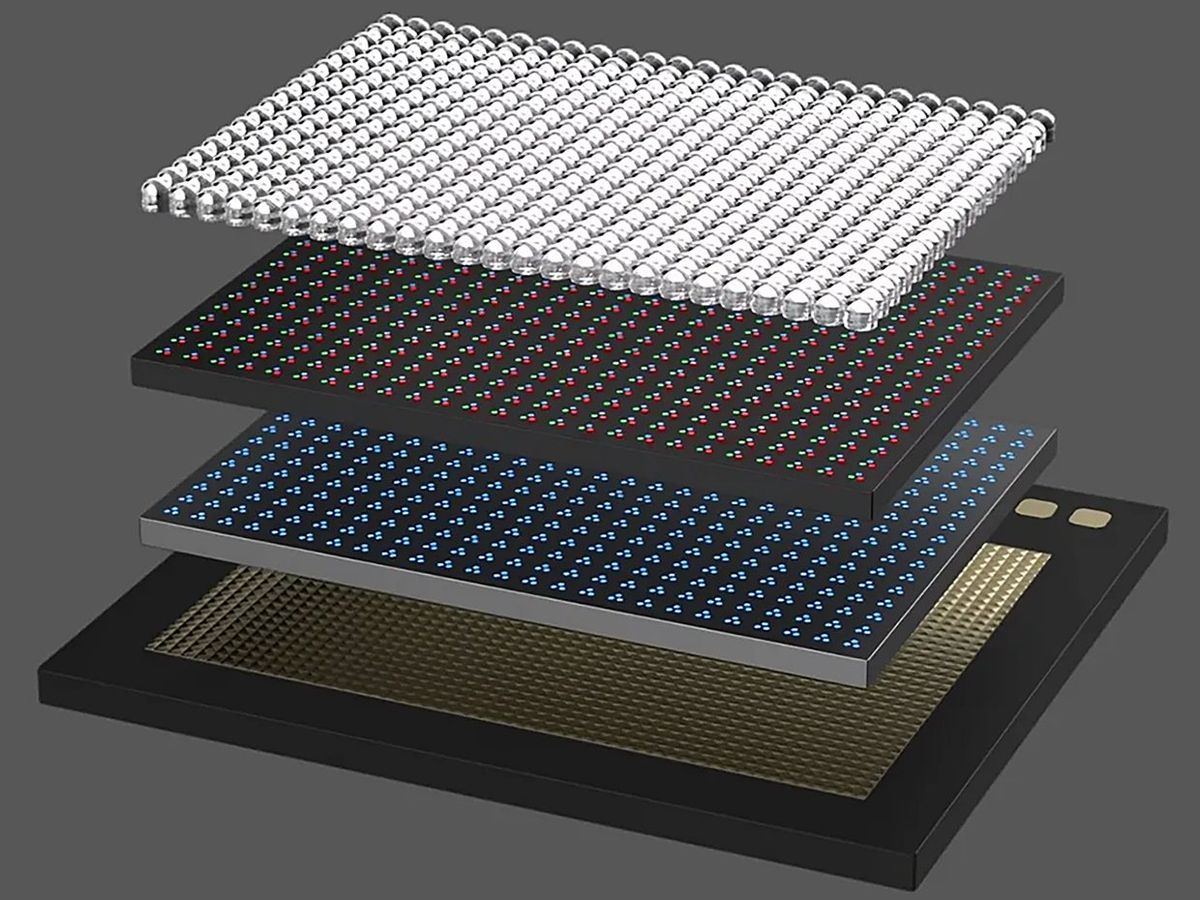The latest microLED breakthrough will have you seeing red—even in the world’s smallest augmented-reality applications.
Mojo Vision made headlines in 2022 when its former CEO, Drew Perkins, slipped the company’s AR contact lens into his eye. The lens packed a tiny green microLED display with an astounding 14,000 pixels per inch. Mojo Vision has since canceled the contact lens, pivoting to microLED displays for next-generation AR devices that are smaller, lighter, and less obtrusive than Apple’s new Vision Pro.
“The separation [between AR and VR] is basically around the question of, if you pass on the street, do they do a double take?” says Nikhil Balram, Mojo Vision’s new CEO. “If you’re making a mass-scale device, something a billion people will use someday, it needs to be something that feels normal.”
Red microLEDs are vital for comfortable AR
AR devices must deliver impressive (or at least usable) visuals, yet remain slim, light, and comfortable to wear. A microLED’s extreme pixel density makes it ideal for this task, but the technology has difficulty producing a full spectrum of color.
LEDs are bandgap semiconductors that produce a wavelength of light dependent on the materials used. Indium gallium nitride (InGaN) is a common choice and can produce blue or green with (relative) ease, as Mojo Vision demonstrated with the reveal of its 300-millimeter GaN-on-silicon wafer in May 2023.
Red is more difficult. Strong, pure red light has a wavelength of around 700 nanometers, which is much longer than blue (around 450 nm) or green (around 530 nm). Adding indium shifts the wavelength of light toward red but also lowers efficiency.

“Indium is a big atom. As you add more Indium you get more disruption in the semiconductor. Instead of getting light, you get these defects, and you get heat,” says Balram. “You say, okay, I want to get red, so you keep adding indium, and things are going to hell in a handbasket, and efficiency is falling off a cliff.”
Mojo Vision keeps everything from falling apart by using quantum dots, a technology that can shift short-wavelength light to nearly any visible color. High-end HDTVs use quantum dots to display a wider range of color than a LED or OLED panel can produce on its own. Mojo Vision’s use is similar, though more specific, shifting the wavelength of light produced by its blue GaN-on-silicon wafer toward red. This sidesteps the usual problems that stem from adding indium.
With red conquered, Mojo Vision has the pieces to puzzle together a red, green, and blue (RGB) microLED display. The company has yet to announce such a display, but it’s the obvious next step. “The fundamental problem that most everyone is stuck on is how to do [red, blue, and green] together,” says Balram. “Our approach is to take blue LEDs and put red and green quantum dots on top of these. No one else has shown you can make such small red LEDs by using quantum dots.”
Apple’s Vision Pro has nothing on microLEDs
Mojo Vision’s red microLED announcement comes on the heels of Apple’s Vision Pro, a device that’s sure to dominate conversations about augmented reality in the coming year. The Vision Pro has a remarkable microOLED display with a pixel size of just 7.5 micrometers and a maximum brightness of 5,000 nits.
Apple’s display defeats most current AR/VR headsets, but Mojo Vision’s microLED technology is in another league entirely. It has demonstrated displays that pack up to 28,000 pixels per inch, and its red microLED has a diameter of just 1.37 µm (with a pixel pitch of 1.87 µm). It also targets a much higher level of brightness. “The standard requirement for a customer for us is 1 million nits,” says Balram.
Mojo Vision has partnered with DigiLens to “accelerate development” of next-generation AR devices.ARGO
It’s plausible that microLEDs could someday overthrow microOLEDs in large, enclosed headsets like the Apple Vision Pro, but that’s not Mojo Vision’s goal. The company is targeting slimmer, less obstructive AR devices that need a small, bright display. Unlike Apple’s “spatial computing,” which is meant to be enjoyed at home or while seated, Mojo Vision wants to enable AR devices that can be used both indoors and outdoors.
The company’s contact lens was one example. Transparent augmented-reality glasses are another. Most augmented-reality glasses with a transparent lens use a diffractive waveguide that bends light from a display located in the frame. Mojo Vision has partnered with DigiLens, creator of the Argo AR smart glasses, to “accelerate development” of future DigiLens AR headsets.
“The efficiency of those optics is less than 1 percent,” says Balram. “That means if I want 10,000 nits to the eye, because I’m looking at a sunlit scene, I need over a million nits from the display. So, that’s a fundamental driver for microLED if you want compact, nice-looking optics.”
- This MicroLED Display Is Smaller Than a Bug ›
- Large-Area MicroLED Display Startup Makes Gallium-Nitride Transistors Too ›
Matthew S. Smith is a freelance consumer technology journalist with 17 years of experience and the former Lead Reviews Editor at Digital Trends. An IEEE Spectrum Contributing Editor, he covers consumer tech with a focus on display innovations, artificial intelligence, and augmented reality. A vintage computing enthusiast, Matthew covers retro computers and computer games on his YouTube channel, Computer Gaming Yesterday.



